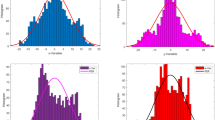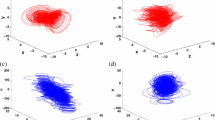Abstract
This research explores the various chaotic features of the hyperchaotic Chen dynamical system within a variable order fractional (VOF) calculus framework, employing an innovative approach with a nonlinear and adaptive radial basis function neural network. The study begins by computing the numerical solution of VOF differential equations for the hyperchaotic Chen system through a numerical scheme using the Caputo–Fabrizio derivative across a spectrum of different system control parameters. Subsequently, a comprehensive parametric model is formulated using RBFNN, considering the system’s various initial values. We systematically investigate the various chaotic attractors of the proposed system, employing statistical analysis, phase space reconstruction, and Lyapunov exponent. Additionally, we assess the effectiveness of the proposed computational RBFNN model using the Root Mean Square Error statistic. Importantly, the obtained results closely align with those derived from numerical algorithms, emphasizing the high accuracy and reliability of the designed network. The outcomes of this study have implications for studying chaos with variable fractional derivatives, with applications across various scientific and engineering domains. This work advances the understanding and applications of variable order fractional dynamics.




























Similar content being viewed by others
Data availability
This research work has no associated data.
References
Ahuja B, Doriya R (2021) Visual chaos steganography with fractional transform. In: Soft computing and signal processing. Springer, pp 295–304
Alkahtani BST, Koca I, Atangana A (2016) A novel approach of variable order derivative: theory and Methods. J Nonl Sci Appl 9(6):4867–4876
Ardjouni A, Djoudi A (2020) Existence and uniqueness of positive solutions for first-order nonlinear Liouville-Caputo fractional differential equations. São Paulo J Math Sci 14(1):381–390
Aslam M S, Radhika T, Chandrasekar A, Zhu Q (2024) Improved event-triggered-based output tracking for a class of delayed networked T–S fuzzy systems. Int J Fuzzy Syst 1–14
Atangana A, Aguilar JFG, Kolade MO, Hristov JY (2020) Fractional differential and integral operators with non-singular and non-local kernel with application to nonlinear dynamical systems. Chaos Solitons Fract 132:109493
Atangana A, Araz Sİ (2021) New concept in calculus: piecewise differential and integral operators. Chaos Solitons Fract 145:110638
Atangana A, Baleanu D (2016) New fractional derivatives with nonlocal and non-singular kernel: theory and application to heat transfer model. Therm Sci 20(2):763–769
Atangana A, Botha JF (2013) A generalized groundwater flow equation using the concept of variable-order derivative. Bound Value Problems 2013:1–11
Bukhari AH, Raja MAZ, Rafiq N, Shoaib M, Kiani AK, Shu CM (2022) Design of intelligent computing networks for nonlinear chaotic fractional Rossler system. Chaos Solitons Fract 157:111985
Bukhari AH, Shoaib M, Kiani AK, Chaudhary NI, Raja MAZ, Shu CM (2023) Dynamical analysis of nonlinear fractional order Lorenz system with a novel design of intelligent solution predictive radial base networks. Math Comput Simul 213:324–347
Chen WC (2008) Nonlinear dynamics and chaos in a fractional-order financial system. Chaos Solitons Fract 36(5):1305–1314
Chen SB, Jahanshahi H, Abba OA, Solís-Pérez JE, Bekiros S, Gómez-Aguilar JF, Yousefpour A, Chu YM (2020) The effect of market confidence on a financial system from the perspective of fractional calculus: Numerical investigation and circuit realization. Chaos Solitons Fract 140:110223
Chen G, Ueta T (1999) Yet another chaotic attractor. Int J Bifurc Chaos 9(07):1465–1466
Dlamini A, Goufo EFD, Khumalo M (2021) On the Caputo–Fabrizio fractal fractional representation for the Lorenz chaotic system. AIMS Math 6(11):12395–12421
Długosz M, Skruch P (2016) The application of fractional-order models for thermal process modelling inside buildings. J Building Phys 39(5):440–451
Gul T, Qadeer A, Alghamdi W, Saeed A, Mukhtar S, Jawad M (2021) Irreversibility analysis of the couple stress hybrid nanofluid flow under the effect of electromagnetic field. Int J Numer Meth Heat Fluid Flow 32(2):642–659
Gupta A, Kumar S (2021) Design of Atangana–Baleanu-Caputo fractional-order digital filter. ISA Trans 112:74–88
Hegazi AS, Matouk AE (2011) Dynamical behaviors and synchronization in the fractional order hyperchaotic Chen system. Appl Math Lett 24(11):1938–1944
Homaeinezhad MR, Shahhosseini A (2020) Fractional order actuation systems: theoretical foundation and application in feedback control of mechanical systems. Appl Math Model 87:625–639
Jadoon I, Raja MAZ, Junaid M, Ahmed A, ur Rehman A, and Shoaib M (2021) Design of evolutionary optimized finite difference based numerical computing for dust density model of nonlinear Van-der Pol Mathieu’s oscillatory systems. Math Comput Simul 181:444–470
Jahanshahi H, Yousefpour A, Munoz-Pacheco JM, Kacar S, Pham VT, Alsaadi FE (2020) A new fractional-order hyperchaotic memristor oscillator: dynamic analysis, robust adaptive synchronization, and its application to voice encryption. Appl Math Comput 383:125310
Kulish VV, Lage JL (2002) Application of fractional calculus to fluid mechanics. J Fluids Eng 124(3):803–806
Li C, Chen G (2004) Chaos and hyperchaos in the fractional-order Rössler equations. Phys A 341:55–61
Li CK, Li RC (2005) A note on eigenvalues of perturbed Hermitian matrices. Linear Algebra Appl 395:183–190
Liang L, Guo W, Zhang Y, Zhang W, Li L, Xing X (2020) Radial Basis Function Neural Network for prediction of medium-frequency sound absorption coefficient of composite structure open-cell aluminum foam. Appl Acoust 170:107505
Lin Z, Wang H (2021) Modeling and application of fractional-order economic growth model with time delay. Fract Fract 5(3):74
Lin H, Wang C, Yu F, Hong Q, Xu C, Sun Y (2023) A triple-memristor hopfield neural network with space multi-structure attractors and space initial-offset behaviors. IEEE Trans Comput Aided Des Integr Circuits Syst 42(12):4948–4958
Matuš\(\mathring{{\rm u}}\) R (2011) Application of fractional order calculus to control theory. Int J Math Models Methods Appl Sci 5(7):1162–1169
Mirzaee F, Alipour S (2020) Cubic B-spline approximation for linear stochastic integro-differential equation of fractional order. J Comput Appl Math 366:112440
Nasser-Eddine A, Huard B, Gabano JD, Poinot T (2019) A two steps method for electrochemical impedance modeling using fractional order system in time and frequency domains. Control Eng Pract 86:96–104
Naz S, Raja MAZ, Kausar A, Zameer A, Mehmood A, Shoaib M (2022) Dynamics of nonlinear cantilever piezoelectric-mechanical system: An intelligent computational approach. Math Comput Simul 196:88–113
Owolabi KM, Karaagac B (2020) Dynamics of multi-pulse splitting process in one-dimensional Gray–Scott system with fractional order operator. Chaos Solitons Fract. 136:109835
Parsa Moghaddam B, Yaghoobi S, Tenreiro Machado JA (2016) An extended predictor corrector algorithm for variable order fractional delay differential equations. J Comput Nonlinear Dyn 1:1–11
Patnaik S, Hollkamp JP, Semperlotti F (2020) Applications of variable-order fractional operators: a review. Proc R Soc A 476(2234):20190498
Prommee P, Pienpichayapong P, Manositthichai N, Wongprommoon N (2021) OTA-based tunable fractional-order devices for biomedical engineering. AEU-Int J Electron Commun 128:153520
Radhika T, Chandrasekar A, Vijayakumar V, Zhu Q (2023) Analysis of Markovian jump stochastic Cohen-Grossberg BAM neural networks with time delays for exponential input-to-state stability. Neural Process Lett 55(8):11055–11072
Samko SG (1995) Fractional integration and differentiation of variable order. Anal Math 21(3):213–236
Sha Y, Mou J, Banerjee S, Zhang Y (2023) Exploiting flexible and secure cryptographic technique for multi-dimensional image based on graph data structure and three-input majority gate. IEEE Trans Industr Inf 20:3
Sheng H, Sun H, Chen Y, Qiu T (2011) Synthesis of multifractional Gaussian noises based on variable-order fractional operators. Signal Process 91(7):1645–1650
Sheng H, Sun HG, Coopmans C, Chen YQ, Bohannan GW (2011) A physical experimental study of variable-order fractional integrator and differentiator. Eur Phys J Spec Top 193:93–104
Solís-Pérez JE, Gómez-Aguilar JF, Atangana A (2018) Novel numerical method for solving variable-order fractional differential equations with power, exponential and Mittag-Leffler laws. Chaos Solitons Fract 114:175–185
Sun H, Chen W, Chen Y (2009) Variable-order fractional differential operators in anomalous diffusion modeling. Phys A 388(21):4586–4592
Sun J, Zhai Y, Liu P, Wang Y (2024) Memristor-based neural network circuit of associative memory with overshadowing and emotion congruent effect. IEEE Trans Neural Networks Learn Syst 1–13
Tseng CC (2006) Design of variable and adaptive fractional order FIR differentiators. Signal Process 86(10):2554–2566
Ullah S, Ullah O, Khan MA, Gul T (2020) Optimal control analysis of tuberculosis (TB) with vaccination and treatment. Eur Phys J Plus 135:1–27
Wang S, He S, Yousefpour A, Jahanshahi H, Repnik R, Perc M (2020) Chaos and complexity in a fractional-order financial system with time delays. Chaos Solitons Fract 131:109521
Wang XY, Song JM (2009) Synchronization of the fractional order hyperchaos Lorenz systems with activation feedback control. Commun Nonlinear Sci Numer Simul 14(8):3351–3357
Xu Q, Liu T, Ding S, Bao H, Li Z, Chen B (2023) Extreme multistability and phase synchronization in a heterogeneous bi-neuron Rulkov network with Memristive electromagnetic induction. Cogn Neurodyn 17(3):755–766
Yousefpour A, Jahanshahi H, Munoz-Pacheco JM, Bekiros S, Wei Z (2020) A fractional-order hyper-chaotic economic system with transient chaos. Chaos Solitons Fract 130:109400
Yu F, Yuan Y, Wu C, Yao W, Xu C, Cai S, Wang C (2024) Modeling and hardware implementation of a class of Hamiltonian conservative chaotic systems with transient quasi-period and multistability. Nonlinear Dyn 112(3):2331–2347
Yépez-Martínez H, Gómez-Aguilar JF (2019) A new modified definition of Caputo–Fabrizio fractional-order derivative and their applications to the multi step homotopy analysis method (MHAM). J Comput Appl Math 346:247–260
Zafarghandi FS, Mohammadi M, Babolian E, Javadi S (2019) Radial basis functions method for solving the fractional diffusion equations. Appl Math Comput 342:224–246
Zhou T, Tang Y, Chen G (2003) Complex dynamical behaviors of the chaotic Chen’s system. Int J Bifurc Chaos 13(09):2561–2574
Acknowledgements
We are grateful to the editor and anonymous reviewers for reviewing the manuscript and providing constructive comments for improvement. The authors would like to thank Prince Sultan University for their support.
Author information
Authors and Affiliations
Corresponding author
Ethics declarations
Conflict of interest
The authors declare that they have no conflict of interest.
Additional information
Publisher's Note
Springer Nature remains neutral with regard to jurisdictional claims in published maps and institutional affiliations.
Rights and permissions
Springer Nature or its licensor (e.g. a society or other partner) holds exclusive rights to this article under a publishing agreement with the author(s) or other rightsholder(s); author self-archiving of the accepted manuscript version of this article is solely governed by the terms of such publishing agreement and applicable law.
About this article
Cite this article
Hussain, S., Bashir, Z. & Malik, M.G.A. Chaos analysis of nonlinear variable order fractional hyperchaotic Chen system utilizing radial basis function neural network. Cogn Neurodyn (2024). https://doi.org/10.1007/s11571-024-10118-9
Received:
Revised:
Accepted:
Published:
DOI: https://doi.org/10.1007/s11571-024-10118-9




